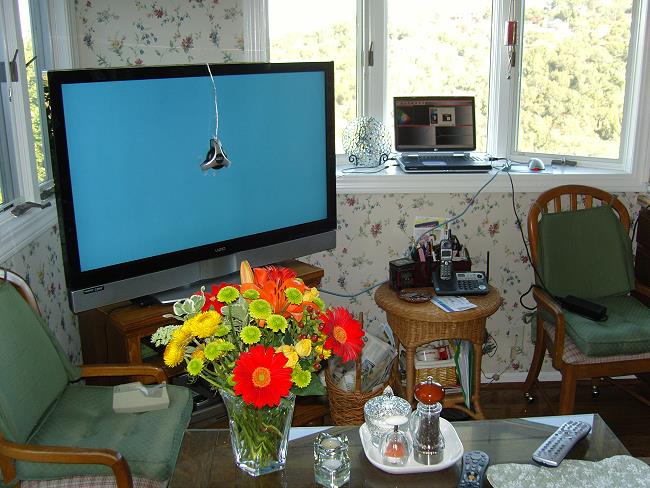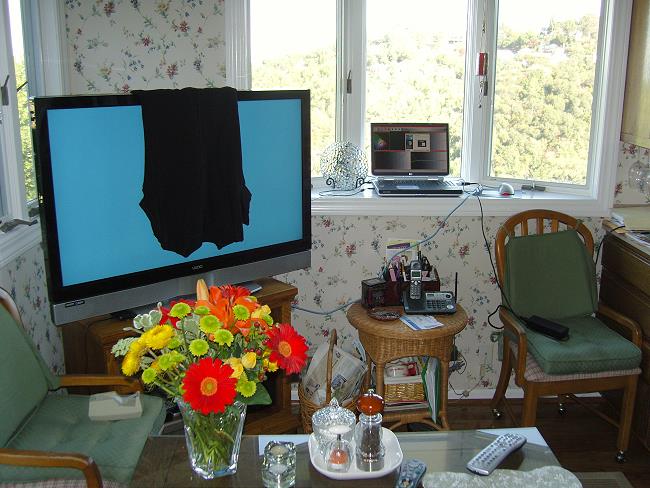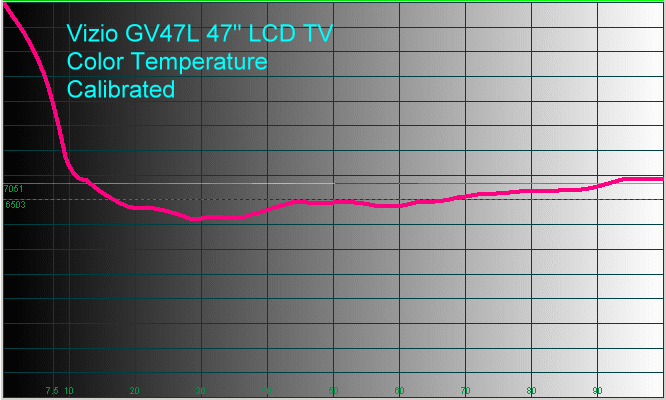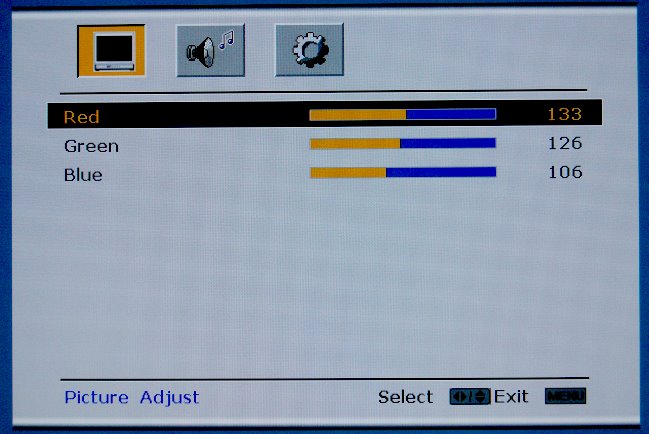On the Bench
Here is the test setup, in my kitchen. I used
one of the HDMI inputs, being fed ColorFacts test patterns from my laptop.
The first photo shows the sensor on the front of the TV, but I ran the tests
with a black cloth over the TV, as shown in the second photo.


First, the data in the uncalibrated condition.
I used the Custom mode, with the tint set to 0, and other options set to
near midlevel positions. Features in the Advanced Picture Adjust menu were
set to Off.
The Color Temperature is high all the way
across the IRE field. Too blue.

This is shown further in the RGB
graph, below. Blue is way off, green is about right, and there is not enough
red.

The gamma is best fit by a value
of 1.64, which is too low. Notice that the lower IRE levels are too low,
which is that gray level crush I mentioned previously.

The CIE chart (white triangle is the Vizio
data vs. the dark triangle which is the CIE 1931 standard) shows that there
is enough red and green (but the green tends to be on the blueish side, and
the red is a bit orange), but
not enough blue (this refers to blue capability, not its setting). Ironic, since the blue was
set too high in the color
temperature measurement. The CIE standard shows the color gamut that a TV
should be able to reproduce. The test result CIE is the gamut that the TV
actually can reproduce.

Now for the measurements in the calibrated
condition.
The color temperature is closer to the D6500
standard, except at below 10 IRE where the blue leakage takes over.

The RGB lines are now much closer to where
they should be.

However, gamma is still too low.

The CIE in the calibrated condition is shown
below. It is exactly the same as in the uncalibrated condition. This points
out what the CIE measures, namely what the TV is capable of, not what the
menu settings are.

Here is the RGB menu with the colors
calibrated. The factory default value was 128 for all three colors. These
RGB adjustments let you set the overall balance of the three primary colors.
Adjusting "Tint" in the main menu is just a way of tweaking the image so
that faces don't look too red or too green.

I measured an On/Off Contrast
Ratio (CR) of 351:1 in the uncalibrated condition, and 333:1 in calibrated
form.
I then turned on most of the
Advanced Picture Adjust features, as shown below.

In this situation, On/Off CR increased to
1183:1, and the image was much brighter (137.8 Foot-Lamberts - which is
472.2 cd/m2 - compared to
58.3 Foot-Lamberts - which is 199.8 cd/m2 - with the AI off), due to the AI selection in the
menu. The gamma increased slightly to 1.77, but the color temperature and
RGB graphs stayed about the same. I decided to use that configuration
(AI on) when watching TV during the day,
and the AI turned off when viewing at night.
Conclusions
Although having a few limitations, like not
being able to adjust the picture when in certain modes, and having more
falloff than some (much more expensive) flat panel LCD HDTVs, the Vizio
GV47L - which has full 1920 x 1080 resolution - is a steal at $1,599. There
really is no excuse not to have a nice big HDTV like this for sports
programs now that they are so affordable. Isn't that why we want one in the
first place?
DirecTV just announced that they will have 70
HD channels available by this Fall. So, what are you waiting for?
- John E. Johnson, Jr. -